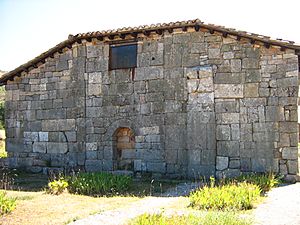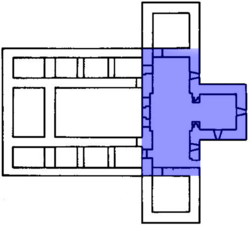Hermitage of Santa María de Lara facts for kids
The church of Santa María de Lara, also known as the Ermita (meaning a small hermitage or chapel), is a very old church in Spain. Many experts believe it is one of the few remaining churches built by the Visigoths, an ancient group of people who lived in the Iberian Peninsula (modern-day Spain and Portugal). It is located near a village called Quintanilla de las Viñas, close to the city of Burgos in the Castile and León region.
While Archeologists are still studying its exact age, most scholars think it was built between the 7th and 10th centuries. This church is special not just because it's so old and has unique architecture, but also because it might have the oldest picture of Christ in Spanish religious art. Because of its importance, it was officially named a national monument on November 25, 1929.
Contents
History of Santa María de Lara
Building the Ancient Church
Before the church was built, the area around Santa María de Lara was home to many Roman villas, which were like large country houses. After the Visigoths arrived in Spain and the Romans left, the Visigoths settled in Quintanilla de las Viñas. They built the church of Santa María de Lara around the early 8th century.
However, in 711 AD, the Moors (people from North Africa) invaded Spain. Many people, including those from Lara, fled north to the Picos de Europa mountains, and the church was left empty.
Rebuilding and New Life
In the 9th century, during a time known as the Spanish Reconquista (when Christian kingdoms slowly took back land from the Moors), areas like Lara were resettled. Many buildings were in ruins, including Santa María de Lara. The church needed to be rebuilt.
A special stone slab, called a funerary stela, now kept in the Museum of Burgos, helps us understand when the church was rebuilt. It has the letters DCCCC carved on it. Experts believe this refers to the year 902. This is because the inscription uses an old Spanish dating system where you subtract 38 years to get the modern calendar year.
In 967 AD, an old document shows that a woman named Muniadona, who was the mother of a powerful leader named Fernán González of Castile, gave money to the church and a nearby monastery. However, historians don't know exactly where this monastery was located.
By 1038, the church was given to the nearby monastery of San Pedro de Arlanza. After this, Santa María de Lara slowly became less important and parts of its building started to fall apart. Later documents from the Archbishopric of Burgos simply called it a 'hermitage'. Eventually, the church was abandoned, and much of its beautiful old carvings and decorations were lost.
Rediscovery and Modern Care
For centuries, Santa María de Lara was forgotten, hidden by thick bushes. Then, in 1921, a local parish priest named Don Bonifacio Zamora was walking near Quintanilla de las Viñas and found the church's remains. He worked hard to get historians and experts interested in his discovery.
At first, he wasn't successful, and the site was even used as a corral for farm animals until 1927. That year, experts like Helmut Schlunk, a famous German scholar, finally learned about the church. They visited this "newly discovered" Visigothic church to study it.
After two years of study, Santa María de Lara was declared a 'National Monument' on November 25, 1929. In the 1930s, big excavations were done, which uncovered a lot of information showing that people had lived in the area for a very long time. Most of what we know about the church today comes from the research done in the 1920s and 1930s. Many of the artefacts found, like stone slabs, ancient stone structures called dolmens, and objects from Roman villas, are now displayed in the 'Museo Provincial de Burgos'.
Until the 1970s, you could only reach the church by a small local road. Then, Jesus Vicario Moreno, who cared for Santa María de Lara and showed it to visitors for many years, helped build a paved asphalt road from Quintanilla de las Viñas. Visitors and tourism have helped provide money to keep the church stable and protect it, for example, by adding a modern wooden roof. The number of visitors has grown a lot; in 1992, 8,000 tourists came to see the site.
Stolen Art Recovered
In 2004, two carved stones showing important religious figures were stolen from the church. Years later, in 2010, a tip was received that they were being sold as garden decorations in Great Britain. A Dutch art detective named Arthur Brand found them in a British garden. In January 2019, they were returned to the Spanish embassy.
People Connected to the Church
Lady Flammola's Gift
An inscription carved on the right side of the main arch inside the church mentions a Lady Flammola. The Latin words, + OC EXIGUUM EXIGUA OFF(ERO) D(E)O FLAMMOLA VOTUM, are believed to mean, "Flammola, the least of the least, makes this promised offering to God." Another way to translate it is, "This small gift the Lady Flammola offers to God."
Historians sometimes call this Lady Flammola "Dona Lambra." She might have paid for the restoration of the church in the 10th century and supported it with her money. However, many women from that time had the same name. Without a more exact date for the inscription, scholars can't be sure which specific Flammola helped restore the church.
The Fernán González Family
Muniadona, who gave a donation to the church in 967 AD, was the mother of Count Fernán González of Castile. He was a very important leader who ruled over Castile.
Fernán González of Castile, who was the first independent count of Castile, had strong ties to the church for a few reasons:
- He was part of the important Lara family, and the church shares its name with them.
- He grew up in and later commanded the castle of Lara, which you can see from Santa María de Lara on a clear day.
- He was buried in the monastery of San Pedro de Arlanza, which owned Santa María de Lara at that time.
See also
 In Spanish: Ermita de Santa María (Quintanilla de las Viñas) para niños
In Spanish: Ermita de Santa María (Quintanilla de las Viñas) para niños



